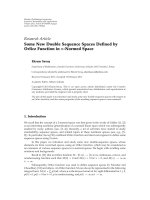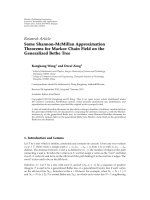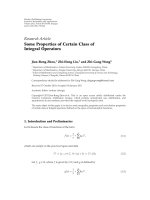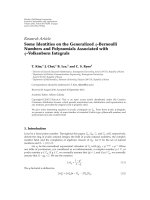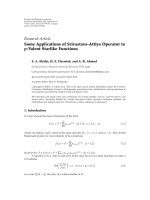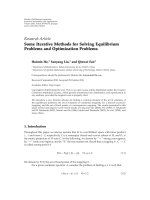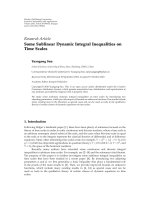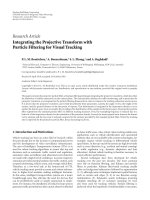Báo cáo hóa học: " Research Article Some Characteristic Quantities Associated with Homogeneous P-Type and M-Type Functions" potx
Bạn đang xem bản rút gọn của tài liệu. Xem và tải ngay bản đầy đủ của tài liệu tại đây (505.81 KB, 10 trang )
Hindawi Publishing Corporation
Journal of Inequalities and Applications
Volume 2007, Article ID 84146, 10 pages
doi:10.1155/2007/84146
Research Article
Some Characteristic Quantities Associated with Homogeneous
P-Type and M-Type Functions
Ya-Ping Fang, Nan-Jing Huang, and Yeol Je Cho
Received 22 November 2006; Accepted 20 March 2007
Recommended by Patricia J. Y. Wong
Several characteristic quantities associated with homogeneous P-type and M-type func-
tions are introduced and studied in this paper. Further, the concepts of P-property and
M-property for a couple of functions are introduced and some quantities for a pair of ho-
mogeneous functions having P-property and M-propert y are obtained, respectively. As
an application, a bound for the solution of the homogeneous complementarity problem
with a P-type function is derived.
Copyright © 2007 Ya-Ping Fang et al. This is an open access article distributed under the
Creative Commons Attribution License, which permits unrestricted use, distribution,
and reproduction in any medium, provided the original work is properly cited.
1. Introduction
For any given P-matr ix [1](see also [2–4]), M
∈ R
n×n
, Mathias and Pang [5]introduced
a quantity α(M)by
α(M)
= min
x
∞
=1
max
1≤i≤n
x
i
(Mx)
i
. (1.1)
In terms of α(M), a bound for the solution of the linear complementarity problem
LCP(M,q) (see [2–4]) with a P-matrix M is established in [5]. Recently, Xiu and Zhang
[6] further gave some new properties of α(M) and introduced a new quantity β(M),
which is defined by
β(M)
= max
x
∞
=1
max
1≤i≤n
x
i
(Mx)
i
. (1.2)
2 Journal of Inequalities and Applications
Moreover , Xiu and Zhang [6] introduced a fundamental quantity α
{A,B} associated with
apair
{A,B} having v-column P-property (see [2–4, 7]) by
α
{A,B}= min
x
∞
=1
max
1≤i≤n
(Ax)
i
(Bx)
i
, (1.3)
where A,B
∈ R
m×n
. They de veloped some characteristic quantities of α{A,B}. By means
of these quantities, Xiu and Zhang [6] established global error bounds for the vertical and
horizontal linear complementarity problems.
Motivated by these works, in this paper, we introduce the concepts of P-type and M-
type functions and give several quantities for homogeneous P-ty pe and M-type func-
tions. Furtherm ore, we give the concepts of P-property and M-property for a couple of
functions, and obtain some quantities for homogeneous continuous pair with P-property
and M-property, respectively. As an application, a bound of the solution to the homoge-
neous complementarit y problem with a P-type function is obtained.
2. Characteristic quantities for P-Type and M-Type functions
Let T :
R
n
→ R
n
be a function. We say that T is positively homogeneous with degree θ>0
if T(λx)
= λ
θ
T(x)forallx ∈ R
n
and λ>0. Define Ᏼ by
Ᏼ
=
T|T : R
n
−→ R
n
is continuous and positively homogeneous
. (2.1)
Given T
∈ Ᏼ,define
T= max
x=1
T(x)
=
sup
x=0
T(x)
x
θ
, (2.2)
where θ>0 is the positively homogeneous degree of T and
·is a norm on R
n
.
Theorem 2.1. Let T,S :
R
n
→ R
n
be two positively homogeneous functions with degrees θ
and ρ, respectively. Then the following conclusions hold:
(i)
T(x)≤T·x
θ
;
(ii) if the inverse T
−1
in Ᏼ exists, then T
−1
is positively homogeneous with degree 1/θ;
(iii)
T · S≤T·S
θ
.
Proof. (i) This follows directly from (2.2).
(ii) Since T
−1
∈ Ᏼ,wesupposethedegreeofT
−1
is θ
. It follows that
T
−1
· T
(λx) = λx = T
−1
λ
θ
T(x)
=
λ
θθ
T
−1
· T
(x) = λ
θθ
x. (2.3)
Hence θ
= 1/θ.
Ya-Ping Fang et al. 3
(iii) It is easy to see that T
· S is positively homogeneous with degree θρ.By(2.2),
T · S=sup
x=0
T
S(x)
x
θρ
≤ sup
x=0
T·
S(x)
θ
x
θρ
≤ sup
x=0
T·S
θ
·x
θρ
x
θρ
=T·S
θ
.
(2.4)
This completes the proof.
Let T : R
n
→ R
n
be a function. Recall that T is a P-function (see [3, 4]) if
max
1≤i≤n
x
i
− y
i
T(x) − T(y)
i
> 0 (2.5)
for all x
= y.
We now int roduce the concepts of M-type and P-type functions as follows.
Definit ion 2.2. Let T :
R
n
→ R
n
be a function. T is said to be
(i) M-type if
min
1≤i≤n
x
i
T(x)
i
> 0, ∀x = 0; (2.6)
(ii) P-type if
max
1≤i≤n
x
i
T(x)
i
> 0, ∀x = 0. (2.7)
Note that a P-function T with T(0)
= 0isP-type and a function T : R
n
→ R
n
is M-type
if T(0)
= 0andT
i
: R
n
→ R is strictly monotone for each i,whereT
i
(x) = [T(x)]
i
.
For any given P-type and positively homogeneous function T with degree θ>0, we
define α(T)andβ( T)by
α(T)
= min
x
∞
=1
max
1≤i≤n
x
i
T(x)
i
= inf
x=0
max
1≤i≤n
x
i
T(x)
i
x
θ+1
∞
, (2.8)
β(T)
= max
x
∞
=1
max
1≤i≤n
x
i
(T(x))
i
= sup
x=0
max
1≤i≤n
x
i
(T(x))
i
x
θ+1
∞
, (2.9)
where
x
∞
= max
1≤i≤n
{|x
i
|}. In addition, if T is M-type, we can further define α
(T)
and β
(T)by
α
(T) = max
x
∞
=1
min
1≤i≤n
x
i
(T(x))
i
= sup
x=0
min
1≤i≤n
x
i
T(x)
i
x
θ+1
∞
, (2.10)
β
(T) = min
x
∞
=1
min
1≤i≤n
x
i
T(x)
i
= inf
x=0
min
1≤i≤n
x
i
(T(x))
i
x
θ+1
∞
. (2.11)
Obviously, α(T), β(T), α
(T), and β
(T) are well defined, finite, and positive.
4 Journal of Inequalities and Applications
Remarks 2.3. The definitions of α(T), β(T) associated with a P-type positively homoge-
neous function T generalize the definitions of α(M), β(M) associated with a P-matrix in
[5, 6], respectively.
By (2.8)–(2.11), we can obtain the following proposition.
Proposition 2.4. Let T :
R
n
→ R
n
be a positively homogeneous function with degree θ.
Then the following conclusions hold:
(i) if T is P-type, then
α(T)
x
θ+1
∞
≤ max
1≤i≤n
x
i
T(x)
i
≤ β(T)x
θ+1
∞
; (2.12)
(ii) if T is M-type, then
β
(T)x
θ+1
∞
≤ min
1≤i≤n
x
i
T(x)
i
≤ α
(T)x
θ+1
∞
, (2.13)
β
(T) ≤ α
(T) ≤ α(T) ≤ β(T). (2.14)
Theorem 2.5. Let T :
R
n
→ R
n
be a P-type and positively homogeneous function with de-
gree θ and have inverse T
−1
in Ᏼ. Then the following conclusions hold:
(a) β(T)
≤T
∞
;
(b) α(T)
≤ 1/T
−1
θ
∞
;
(c) 1/
T
−1
θ+1
∞
≤ β(T)/β(T
−1
), α(T)/α(T
−1
) ≤T
1+1/θ
∞
.
Proof. For any nonzero x
∈ R
n
,weknow
x
i
T(x)
i
≤x
∞
·T(x)
∞
≤T
∞
·x
θ+1
∞
, i = 1,2, ,n. (2.15)
By (2.9), we obtain β(T)
≤T
∞
.Hence(a)istrue.
From (2.2)andTheorem 2.1,
T
−1
∞
= sup
x=0
T
−1
(x)
∞
x
1/θ
∞
= sup
y=0
y
∞
T(y)
1/θ
∞
= sup
y=0
y
1+θ
∞
1/θ
T(y)
∞
·y
∞
1/θ
. (2.16)
Since
T(y)
∞
·y
∞
≥ max
1≤i≤n
y
i
(T(y))
i
,wehave
T
−1
∞
≤ sup
y=0
y
1+θ
∞
max
1≤i≤n
y
i
T(y)
i
1/θ
=
sup
y=0
y
1+θ
∞
max
1≤i≤n
y
i
T(y)
i
1/θ
=
1
α(T)
1/θ
(2.17)
and so
α(T)
≤
1
T
−1
θ
∞
. (2.18)
Hence (b) is true.
Ya-Ping Fang et al. 5
From (2.8), (2.9), and Theorem 2.1,weknow
β
T
−1
=
sup
x=0
max
1≤i≤n
x
i
T
−1
(x)
i
x
1+1/θ
∞
= sup
y=0
max
1≤i≤n
y
i
T(y)
i
T(y)
1+1/θ
∞
≥ sup
y=0
max
1≤i≤n
y
i
T(y)
i
T
1+1/θ
∞
·y
1+θ
∞
=
β(T)
T
1+1/θ
∞
,
α
T
−1
=
inf
x=0
max
1≤i≤n
x
i
T
−1
(x)
i
x
1+1/θ
∞
= inf
y=0
max
1≤i≤n
y
i
T(y)
i
T(y)
1+1/θ
∞
≥ inf
y=0
max
1≤i≤n
y
i
T(y)
i
T
1+1/θ
∞
·y
1+θ
∞
=
α(T)
T
1+1/θ
∞
,
(2.19)
which yields the second inequalit y in (c).
By the same arguments, we can prove
β(T)
≥
β(T
−1
)
T
−1
1+θ
∞
, α(T) ≥
α
T
−1
T
−1
1+θ
∞
, (2.20)
which yields the first inequality in (c). This completes the proof.
Similarly, we can obtain the following results.
Theorem 2.6. Let T :
R
n
→ R
n
be an M-type and positively homogeneous function w ith
degree θ and have inverse T
−1
in Ᏼ. Then
(i) β
(T) ≤ 1/T
−1
θ
∞
;
(ii) 1/
T
−1
θ+1
∞
≤ β
(T)/β
(T
−1
), α
(T)/α
(T
−1
) ≤T
1+1/θ
∞
.
Theorem 2.7. Let T,S :
R
n
→ R
n
be two positively homogeneous functions with the same
degree θ. Then the following conclusions hold:
(1) if both T and S are P-type, then β(T + S)
≤ β(T)+β(S);
(2) if T is P-type and S is M-type, then α(T + S)
≥ α(T), β(T + S) ≥ β(T);
(3) if both T and S are M-type, then
β
(T + S) ≥ β
(T)+β
(S), α
(T + S) ≥ max{α
(T), α
(S)},
β
(T + S) ≥ max{β
(T), β
(S)}.
(2.21)
Proof. The facts directly follow from the definitions of α, β, α
, β
, and simple arguments.
Remarks 2.8. Theorems 2.5–2.7 generalize partly Theorems 2.1 and 2.5 of Xiu and Zhang
[6].
3. Extensions
In this section, we introduce the definitions of P-property and M-property for a pair
{T, S} and generalize some results for a function T in Section 2 to a pair {T,S}.
6 Journal of Inequalities and Applications
Definit ion 3.1. Let T,S :
R
n
→ R
n
be two functions. Say that {T,S} has
(1) P-pr operty if for any nonzero x
∈ R
n
,
max
1≤i≤n
(T(x))
i
(S(x))
i
> 0; (3.1)
(ii) M-propertyifforanynonzerox
∈ R
n
,
min
1≤i≤n
(T(x))
i
(S(x))
i
> 0. (3.2)
Let T,S
∈ Ᏼ with positively homogeneous degrees θ and ρ, respectively, and {T,S}
have P-property. Define α{T,S} and β{T,S} as follows:
α
{T, S}= min
x
∞
=1
max
1≤i≤n
T(x)
i
(S(x))
i
= inf
x=0
max
1≤i≤n
(T(x))
i
(S(x))
i
x
θ+ρ
∞
, (3.3)
β
{T, S}= max
x
∞
=1
max
1≤i≤n
T(x)
i
S(x)
i
= sup
x=0
max
1≤i≤n
(T(x))
i
(S(x))
i
x
θ+ρ
∞
. (3.4)
Remarks 3.2. The definitions of α
{T, S}, β{T,S} associated with a positively homoge-
neous function pair
{T, S} having P-property generalize the definitions of α{M,N},
β
{M,N} associated w ith a matrix pair having v-column P-property in [2, 6, 7].
In addition, if
{T, S} has M-property, we can define α
{T, S} and β
{T, S} by
α
{T, S}= max
x
∞
=1
min
1≤i≤n
T(x)
i
S(x)
i
= sup
x=0
min
1≤i≤n
(T(x))
i
(S(x))
i
x
θ+ρ
∞
, (3.5)
β
{T, S}= min
x
∞
=1
min
1≤i≤n
T(x)
i
S(x)
i
= inf
x=0
min
1≤i≤n
(T(x))
i
(S(x))
i
x
θ+ρ
∞
. (3.6)
By the definitions of α
{T, S}, β{T,S}, α
{T, S},andβ
{T, S}, we can obtain the follow-
ing proposition.
Proposition 3.3. Let T,S :
R
n
→ R
n
be two positively homogeneous functions with degrees
θ and ρ, respectively. Then the following conclusions hold:
(i) if
{T, S} has P-property, then
α
{T, S}x
θ+ρ
∞
≤ max
1≤i≤n
T(x)
i
S(x)
i
≤ β{T,S}x
θ+ρ
∞
; (3.7)
(ii) if
{T, S} has M-property, then
β
{T, S}x
θ+ρ
∞
≤ min
1≤i≤n
T(x)
i
S(x)
i
≤ α
{T, S}x
θ+ρ
∞
, (3.8)
β
{T, S}≤α
{T, S}≤α{T,S}≤β{T,S}. (3.9)
Note that, if T
−1
exists, then the condition that {T,S} has P-property (M-property) is
equivalent to the condition that ST
−1
is P-type (M-type).
Theorem 3.4. Let T,S :
R
n
→ R
n
be two positively homogeneous functions with degrees θ
and ρ, respectively. Suppose that
{T, S} has P-property and T has inverse T
−1
in Ᏼ. Then
Ya-Ping Fang et al. 7
the following conclusions hold:
(a) β
{T, S}≤T
∞
·S
∞
;
(b) α
{T, S}≤S
∞
/T
−1
θ
∞
;
(c) 1/
T
−1
θ+ρ
∞
≤ β{T,S}/β(ST
−1
), α{T,S}/α(ST
−1
) ≤T
1+(ρ/θ)
∞
.
Proof. (a) For any nonzero x
∈ R
n
, it follows from (i) of Theorem 2.1 that
T(x)
i
S(x)
i
≤T(x)
∞
·S(x)
∞
≤T
∞
·S
∞
·x
θ+ρ
∞
, i = 1,2, ,n. (3.10)
By (3.4),
β
{T, S}≤T
∞
·S
∞
. (3.11)
(b) From (2.2) and (i) of Theorem 2.1,
T
−1
∞
= sup
x=0
T
−1
(x)
∞
x
1/θ
∞
= sup
y=0
y
∞
T(y)
1/θ
∞
= sup
y=0
y
θ
∞
·
S(y)
∞
1/θ
T(y)
∞
·
S(y)
∞
1/θ
. (3.12)
Since
T(y)
∞
·y
∞
≥ max
1≤i≤n
y
i
(T(y))
i
and S(y)
∞
≤S
∞
·y
ρ
∞
,wehave
T
−1
∞
≤ sup
y=0
S
∞
·y
ρ+θ
∞
max
1≤i≤n
T(y)
i
S(y)
i
1/θ
=S
1/θ
∞
·
sup
y=0
y
ρ+θ
∞
max
1≤i≤n
T(y)
i
S(y)
i
1/θ
=
S
∞
α{T, S}
1/θ
.
(3.13)
This implies that
α
{T, S}≤
S
∞
T
−1
θ
∞
. (3.14)
(c) It follows from (2.9)that
β
ST
−1
=
sup
x=0
max
1≤i≤n
x
i
ST
−1
(x)
i
x
1+ρ/θ
∞
= sup
y=0
max
1≤i≤n
T(y)
i
S(y)
i
T(y)
1+ρ/θ
∞
≥ sup
y=0
max
1≤i≤n
T(y)
i
S(y)
i
T
1+ρ/θ
∞
·y
ρ+θ
∞
=
β{T,S}
T
1+ρ/θ
∞
.
(3.15)
By (3.4)andTheorem 2.1,
T
−1
(y)
∞
≤
T
−1
∞
·y
1/θ
∞
,
β{T,S}=sup
x=0
max
1≤i≤n
T(x)
i
S(x)
i
x
ρ+θ
∞
= sup
y=0
max
1≤i≤n
y
i
ST
−1
(y)
i
T
−1
(y)
ρ+θ
∞
.
(3.16)
8 Journal of Inequalities and Applications
It follows that
β
{T, S}≥sup
y=0
max
1≤i≤n
y
i
ST
−1
(y)
i
T
−1
θ+ρ
∞
·y
1+ρ/θ
∞
=
β
ST
−1
T
−1
θ+ρ
∞
. (3.17)
Hence
1
T
−1
θ+ρ
∞
≤
β{T,S}
β
ST
−1
≤
T
1+ρ/θ
∞
. (3.18)
By similar arguments, we can prove that
1
T
−1
θ+ρ
∞
≤
α{T, S}
α
ST
−1
≤
T
1+ρ/θ
∞
. (3.19)
This completes the proof.
Remarks 3.5. Theorem 3.4 generalizes and improves Theorem 2.7 of Xiu and Zhang [6].
Similarly, we can obtain the following result.
Theorem 3.6. Let T,S :
R
n
→ R
n
be two positively homogeneous functions with degrees θ
and ρ, respectively. Suppose that
{T, S} has M-property and T has inverse T
−1
in Ᏼ. Then
the following conclusions hold:
(1) β
{T, S}≤S
∞
/T
−1
θ
∞
;
(2) 1/
T
−1
θ+ρ
∞
≤ α
{T, S}/α
(ST
−1
), β
{T, S}/β
(ST
−1
) ≤T
1+(ρ/θ)
∞
.
4. An application
In this section, we give a bound for the solution of the homogeneous complementarity
problem, denoted by HCP(T,q), which consists of finding x
∈ R
n
such that
x
≥ 0, T(x)+q ≥ 0, x
T
T(x)+q
=
0, (4.1)
where T :
R
n
→ R
n
is a P-type and positively homogenous function and q ∈ R
n
.
Theorem 4.1. Let T :
R
n
→ R
n
be a P-type and positively homogeneous function with de-
gree θ.SupposethatT has inverse T
−1
in Ᏼ and x is the unique solution of HCP(T,q).
Then
α
T
−1
θ
(−q)
+
∞
≤x
θ
∞
≤
(−q)
+
∞
α(T)
, (4.2)
where (
−q)
+
denotes the nonnegative part of −q.
Proof. If x
= 0, then (−q)
+
= 0. The conclusion holds trivially. In the sequel we always
suppose that x
= 0, equivalently, q is not nonnegative. Since x solves HCP(T, q), by
Proposition 2.4,onehas
α(T)
x
θ+1
∞
≤ max
1≤i≤n
x
i
T(x)
i
= max
1≤i≤n
x
i
(−q)
i
≤ max
1≤i≤n
x
i
(−q)
+
i
≤x
∞
·
(−q)
+
∞
.
(4.3)
Ya-Ping Fang et al. 9
This implies that
x
θ
∞
≤
(−q)
+
∞
α(T)
. (4.4)
It follows from (2.12)that
α
T
−1
y
1+1/θ
∞
≤ max
1≤i≤n
y
i
T
−1
(y)
i
. (4.5)
Thus we have
α
T
−1
T(x)
1+1/θ
∞
≤ max
1≤i≤n
x
i
T(x)
i
. (4.6)
Since T(x)
≥−q,weknowthat|T(x)|≥(T(x))
+
≥ (−q)
+
and so
T(x)
∞
≥
(−q)
+
∞
. (4.7)
By (4.6), (4.7), and the fact that x
i
(T(x)+q)
i
= 0, we know
α
T
−1
(−q)
+
1+1/θ
∞
≤ α
T
−1
T(x)
1+1/θ
∞
≤ max
1≤i≤n
x
i
T(x)
i
= max
1≤i≤n
x
i
(−q)
i
≤x
∞
·
(−q)
+
∞
.
(4.8)
Hence
α
T
−1
θ
(−q)
+
∞
≤x
θ
∞
. (4.9)
This completes the proof.
Acknowledgments
The authors thank the referees for their helpful comments and suggestions leading to
the improvements of this paper. This work was supported by the National Natural Sci-
ence Foundation of China (10671135), the Specialized Research Fund for the Doctoral
Program of Higher Education (20060610005) and the Korea Research Foundation Grant
(KRF-2004-041-C00033).
References
[1] M.FiedlerandV.Pt
´
ak, “On matrices with non-positive off-diagonal elements and positive prin-
cipal minors,” Czechoslovak Mathematical Journal, vol. 12(87), pp. 382–400, 1962.
[2] R. W. Cottle, J S. Pang, and R. E. Stone, The Linear Complementarity Problem, Computer Sci-
ence and Scientific Computing, Academic Press, Boston, Mass, USA, 1992.
[3] G. Isac, Complementarity Problems, vol. 1528 of Lecture Notes in Mathematics, Springer, Berlin,
Germany, 1992.
[4] G. Isac, Topological Methods in Complementarity Theory, vol. 41 of Nonconvex Optimization and
Its Applications, Kluwer Academic Publishers, Dordrecht, The Netherlands, 2000.
[5] R. Mathias and J S. Pang, “Error bounds for the linear complementarity problem with a P-
matrix,” Linear Algebra and Its Applications, vol. 132, pp. 123–136, 1990.
10 Journal of Inequalities and Applications
[6] N. Xiu and J. Zhang, “A characteristic quantity of P-matrices,” Applied Mathematics Letters,
vol. 15, no. 1, pp. 41–46, 2002.
[7] M. S. Gowda, “On the extended linear complementarity problem,” Mathematical Programming,
vol. 72, no. 1, pp. 33–50, 1996.
Ya-Ping Fang: Department of Mathematics, Sichuan University, Chengdu, Sichuan 610064, China
Email address:
Nan-Jing Huang: Depart ment of Mathematics, Sichuan University, Chengdu, Sichuan 610064, China
Email address:
Yeol Je Cho: Department of Mathematics Education and the RINS, Gyeongsang National University,
Chinju 660-701, Korea
Email addresses: ;
